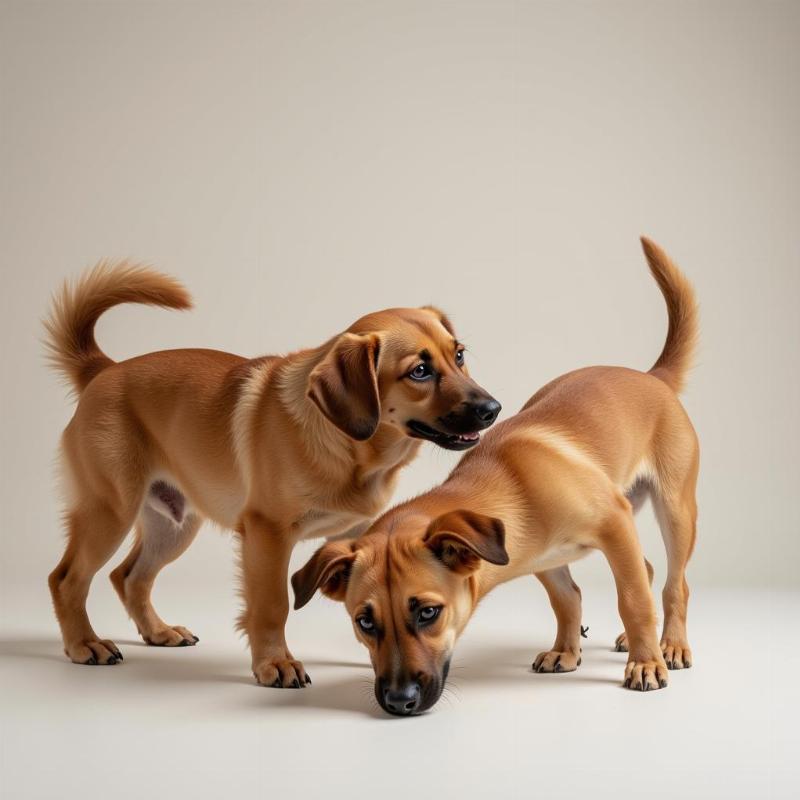A dog growling while wagging its tail can be confusing for any owner. This seemingly contradictory behavior doesn’t necessarily mean your dog is happy, nor does it always signal aggression. Deciphering this mixed message is crucial for ensuring both your dog’s well-being and the safety of those around them. Understanding the context, body language cues, and potential triggers can help you interpret what your furry friend is trying to communicate.
Why Does My Dog Growl and Wag Its Tail at the Same Time?
Dogs communicate through a complex combination of vocalizations and body language. A wagging tail, often associated with happiness, can actually indicate a range of emotions, from excitement and anticipation to anxiety and fear. Similarly, growling doesn’t always signify aggression. It can also be a sign of discomfort, stress, or even playfulness. When these two seemingly opposite behaviors occur together, it’s essential to consider the entire picture.
Context is Key
Where is your dog when they exhibit this behavior? Are they guarding a toy, food, or their favorite spot on the couch? If so, the growling and tail wagging might be a sign of resource guarding, indicating they are possessive and potentially warning others to stay away. Alternatively, if your dog is in a new environment or encountering unfamiliar people or animals, the behavior could stem from anxiety or uncertainty.
Body Language Beyond the Tail Wag
Pay close attention to other body language cues. Is your dog’s body tense? Are their ears pinned back? Are their eyes wide and showing the whites (whale eye)? These signs, coupled with the growling and tail wagging, often indicate fear or stress. A relaxed body posture, playful bowing, and soft eyes, on the other hand, might suggest that the growling is part of a playful interaction. This is particularly common during play sessions with other dogs.
What to Do When Your Dog Growls and Wags Their Tail
If your dog is exhibiting this behavior, it’s crucial to avoid punishment. Scolding or punishing your dog for growling can suppress this important communication signal, making it harder to anticipate potential bites in the future. Instead, focus on understanding the underlying cause of the behavior.
Identifying Triggers
Observe your dog carefully to identify any specific triggers that elicit the growling and tail wagging. Is it a certain person, object, or situation? Once you’ve pinpointed the trigger, you can start working on desensitization and counter-conditioning techniques, ideally with the guidance of a certified professional dog trainer or veterinary behaviorist.
Seeking Professional Help
If you are unsure about the meaning of your dog’s behavior or are concerned about potential aggression, consulting a veterinarian or a certified dog trainer is always the best course of action. They can help you assess the situation, develop a tailored training plan, and ensure both your dog’s well-being and the safety of those around them. Remember, early intervention is key to addressing any behavioral issues.
 Chó gầm gừ và vẫy đuôi khi chơi đùa
Chó gầm gừ và vẫy đuôi khi chơi đùa
Conclusion
A dog growling while wagging their tail presents a complex communication puzzle. By carefully observing the context, accompanying body language, and potential triggers, you can better understand your dog’s emotional state and address any underlying issues. Remember, seeking professional help from a veterinarian or certified dog trainer is crucial for ensuring both your dog’s well-being and the safety of others. Don’t hesitate to reach out for guidance if you’re unsure about how to interpret or address this mixed signal.
FAQ
- Is a wagging tail always a sign of happiness? No, a wagging tail can indicate a range of emotions, including excitement, anxiety, and fear.
- Should I punish my dog for growling? No, punishing a dog for growling can suppress this important communication signal and potentially increase the risk of bites.
- What should I do if my dog growls and wags their tail at the same time? Observe the context, body language, and potential triggers, and consult with a veterinarian or certified dog trainer.
- Can growling be a sign of playfulness? Yes, especially during play sessions with other dogs.
- How can I help my dog if they are anxious or fearful? Work with a certified professional dog trainer or veterinary behaviorist on desensitization and counter-conditioning techniques.
- Is it important to seek professional help for this behavior? Yes, especially if you’re unsure about the cause or concerned about potential aggression.
- What are some resources for finding a qualified dog trainer? The American Kennel Club (AKC) and the Certification Council for Professional Dog Trainers (CCPDT) are good places to start.
Beautdogs.us is your premier resource for all things dog-related in the United States. We offer expert advice on dog breeds, care, and products, catering to both new and experienced dog owners. Our team of dedicated pet professionals is committed to providing reliable and engaging information to help you navigate the joys and challenges of dog ownership. For personalized guidance and support, contact us at [email protected] or call us at +1 501-555-7529. Beautdogs.us is your trusted partner in ensuring a happy and healthy life for your canine companion.